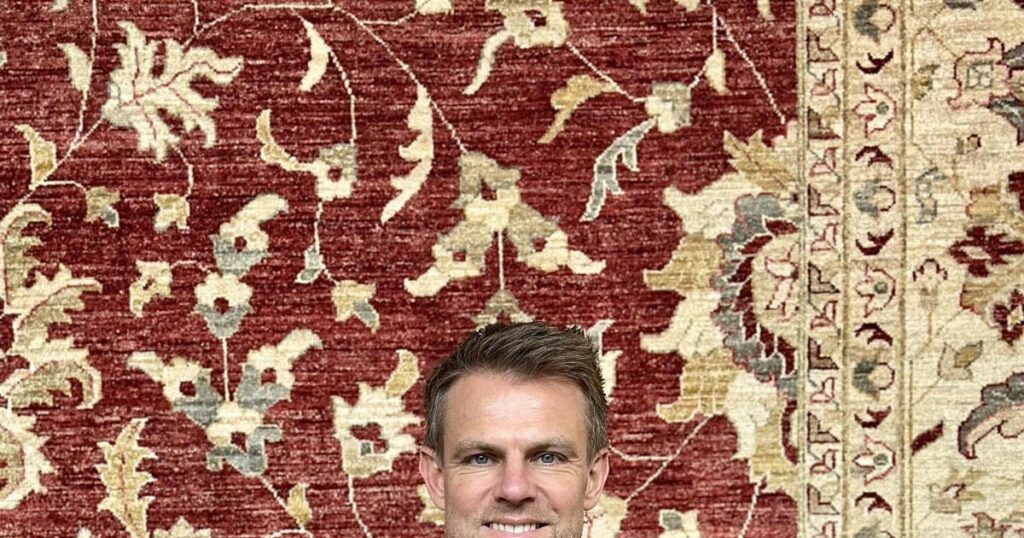Alex Rees caught the rug bug instantly. Just one day into working at his parent’s best friends’ flooring store he’d fallen in love with the hand-knotted artisan rugs. Now he travels the world – mostly to Afghanistan, India, Nepal, Pakistan, and Turkey – to source unique hand-made rugs that can fetch up to £20,000 at his store, Rugs of Petworth, in Petworth, as The Argus’s sister title Sussex Life discovered.
‘Rugs can transform a room and even an entire house,’ Alex, 45, says. ‘They’re all about creativity and craftmanship and as soon as you lay one out you can see its beauty.
‘I have about a thousand in the shop at any one time. There’s everything from tiny mats up to rugs that are 25ft by 15ft and took two years to weave.
‘Like a piece of furniture, they can make a statement. They’re also very versatile and can move with you so they’re a good investment.’
He came to Petworth in 2008 after deciding to set up on his own following years of working for others selling rugs to the public and to the trade. ‘I saw a gap in the market for handmade one-of-a-kind modern classic rugs,’ he says, ‘and I knew Petworth and thought it would be the perfect place to live and open my own store. And we were welcomed with open arms by the public here who have been very supportive right from the beginning.’
It wasn’t always easy though. Alex had to contend with the global recession – ‘it was a bit rocky for a few months and I had to live hand to mouth’– and the pandemic. But he’s built up a following, and moved into bigger premises, in the Old Bakery, in Golden Square, so he has more space to show off the rugs.
Now customers flock to the store from around the world with many Americans ‘nipping down’ while visiting London because they love the ‘English home’ look and rugs he sources on his buying trips.
‘I choose rugs that will still look good in ten years and won’t go out of fashion. Our clients love this signature style and if they can’t find exactly what they want in the store they tell me what they’re after and I look for it on my next trip. I love the challenge of finding the perfect rug for a customer.’
His searches take him along the Silk Road countries where the rugs are made by women in mostly agricultural areas working on looms at home. ‘Everything is done by hand using hand spun wool which is harder wearing than silk,’ Alex explains. ‘A lot of work goes into each rug – it takes a year to make a rug that’s 12ft by 9ft.’
The women receive a ‘natcha’ map of the design hand-drawn on graph paper and either the wool to go with it or they create it freestyle. ‘One of the hardest things about looming is knowing which colour is right for the design,’ Alex says.
‘We only buy rugs from highly reputed producers who treat and pay their weavers fairly. We do our due diligence and go into the villages and the weavers’ homes. It’s a cottage industry but we make sure that it’s ethical. It’s such a privilege to meet the skilled artisans who create such timeless pieces. The high-level skills required in all stages of the process are age-old and handed down through the generations.
Many of the weavers have been doing this for 50 years; they learnt from their mothers who learnt from their mothers. There is a problem, actually, in that many of the younger generation aren’t interested in doing what their parents do, but this is an artisan trade. ‘
Once the rugs are done, they are taken for finishing and washing which is carried out mostly by men in workshops. ‘The finishing is mostly done in Pakistan,’ Alex says. ‘That’s the traditional route via Lahore.’ The rugs are washed – up to four times but at least twice – and are then combed, and clipped before they are stretched and dried on rooftops.
Mats start at £100 while the average 12ft by 9ft rug costs between £1500 – £7-8,000. They can be put in any room – including kitchens where Alex recommends buying a Kilim flat-weave rug which can be spot cleaned though any rug can be professionally washed by his team – and can pull together an entire interiors scheme.
‘We are popular with a lot of interior designers as a rug dresses and finishes off any room,’ he says. ‘Our style is a fresher colour palette though sometimes I do go a bit wild and get something a bit ‘whacky’ – and it always finds a home.’
But that never involves any hard selling, Alex insists. ‘I could see from the early days that the rug industry had some legacy issues associated with it around trust, opacity and integrity, and I always wanted to build a rug business that’s founded on helping people to choose handmade rugs with confidence and good information,’ he says. ‘For this to happen, it’s important that we are as open as possible in sharing the incredible beauty and heritage of rug weaving, the processes and people involved in making them, and how they can be best used to furnish homes.
‘We either have the right rug for a customer’s room, or we don’t. If we stay focussed on sourcing the most beautiful rugs, sharing the amazing story of handmade rug weaving, and being as helpful as possible to our customers, we should be going a long way towards building inspiration in rugs, confidence in the industry and longevity in this precious craft.’
@rughunter
Source link
[Featured]
[Just In]




